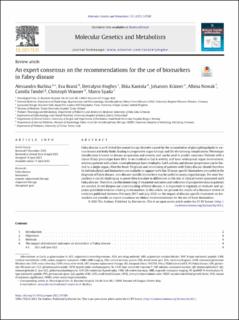| dc.contributor.author | Burlina, Allesandro | |
| dc.contributor.author | Brand, Eva | |
| dc.contributor.author | Hughes, Derralynn A. | |
| dc.contributor.author | Kantola, Ilkka | |
| dc.contributor.author | Krämer, Johannes | |
| dc.contributor.author | Nowak, Albina | |
| dc.contributor.author | Tøndel, Camilla | |
| dc.contributor.author | Wanner, Christoph | |
| dc.contributor.author | Spada, Marco | |
| dc.date.accessioned | 2023-07-13T07:47:36Z | |
| dc.date.available | 2023-07-13T07:47:36Z | |
| dc.date.created | 2023-04-18T20:58:19Z | |
| dc.date.issued | 2023 | |
| dc.identifier.issn | 1096-7192 | |
| dc.identifier.uri | https://hdl.handle.net/11250/3078524 | |
| dc.description.abstract | Fabry disease is an X-linked lysosomal storage disorder caused by the accumulation of glycosphingolipids in various tissues and body fluids, leading to progressive organ damage and life-threatening complications. Phenotypic classification is based on disease progression and severity and can be used to predict outcomes. Patients with a classic Fabry phenotype have little to no residual α-Gal A activity and have widespread organ involvement, whereas patients with a later-onset phenotype have residual α-Gal A activity and disease progression can be limited to a single organ, often the heart. Diagnosis and monitoring of patients with Fabry disease should therefore be individualized, and biomarkers are available to support with this. Disease-specific biomarkers are useful in the diagnosis of Fabry disease; non-disease-specific biomarkers may be useful to assess organ damage. For most biomarkers it can be challenging to prove they translate to differences in the risk of clinical events associated with Fabry disease. Therefore, careful monitoring of treatment outcomes and collection of prospective data in patients are needed. As we deepen our understanding of Fabry disease, it is important to regularly re-evaluate and appraise published evidence relating to biomarkers. In this article, we present the results of a literature review of evidence published between February 2017 and July 2020 on the impact of disease-specific treatment on biomarkers and provide an expert consensus on clinical recommendations for the use of those biomarkers. | en_US |
| dc.language.iso | eng | en_US |
| dc.publisher | Elsevier | en_US |
| dc.rights | Navngivelse 4.0 Internasjonal | * |
| dc.rights.uri | http://creativecommons.org/licenses/by/4.0/deed.no | * |
| dc.title | An expert consensus on the recommendations for the use of biomarkers in Fabry disease | en_US |
| dc.type | Journal article | en_US |
| dc.type | Peer reviewed | en_US |
| dc.description.version | publishedVersion | en_US |
| dc.rights.holder | Copyright 2023 The Authors | en_US |
| dc.source.articlenumber | 107585 | en_US |
| cristin.ispublished | true | |
| cristin.fulltext | original | |
| cristin.qualitycode | 1 | |
| dc.identifier.doi | 10.1016/j.ymgme.2023.107585 | |
| dc.identifier.cristin | 2141698 | |
| dc.source.journal | Molecular Genetics and Metabolism | en_US |
| dc.identifier.citation | Molecular Genetics and Metabolism. 2023, 139 (2), 107585. | en_US |
| dc.source.volume | 139 | en_US |
| dc.source.issue | 2 | en_US |

